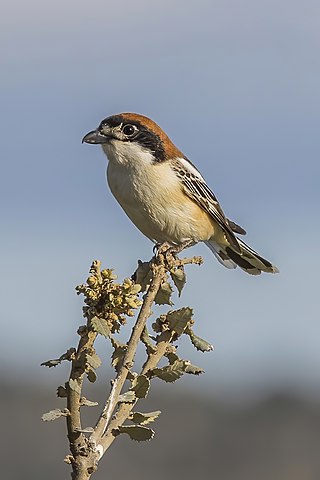
The woodchat shrike is a member of the shrike family Laniidae. It can be identified by its red-brown crown and nape. It is mainly insectivorous and favours open wooded areas with scattered trees such as orchards, particularly when there is bare or sandy ground. The woodchat shrike breeds in southern Europe, the Middle East and northwest Africa, and winters in tropical Africa.

The western marsh harrier is a large harrier, a bird of prey from temperate and subtropical western Eurasia and adjacent Africa. It is also known as the Eurasian marsh harrier. Formerly, a number of relatives were included in C. aeruginosus, which was then known as "marsh harrier". The related taxa are now generally considered to be separate species: the eastern marsh harrier, the Papuan harrier of eastern Asia and the Wallacea, the swamp harrier of Australasia and the Madagascar marsh harrier of the western Indian Ocean islands.
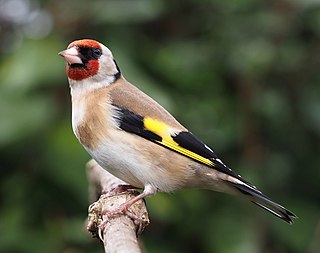
The European goldfinch or simply the goldfinch is a small passerine bird in the finch family that is native to Europe, North Africa and western and central Asia. It has been introduced to other areas, including Australia, New Zealand and Uruguay.

The curlew sandpiper is a small wader that breeds on the tundra of Arctic Siberia.

The Sandwich tern is a tern in the family Laridae. It is very closely related to the lesser crested tern, Chinese crested tern, Cabot's tern, and elegant tern and has been known to interbreed with both elegant and lesser crested. It breeds in the Palearctic from Europe to the Caspian Sea and winters in South Africa, India, and Sri Lanka.
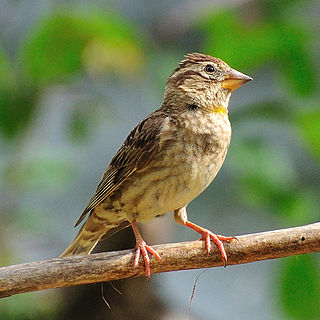
The rock sparrow or rock petronia is a small passerine bird in the sparrow family Passeridae. It is the only member of the genus Petronia. It breeds on barren rocky hills from the Iberian peninsula and western north Africa across southern Europe and through the Palearctic Siberia and north and central China. It is largely resident in the west of its range, but Asian birds migrate to more southerly areas, or move down the mountains.
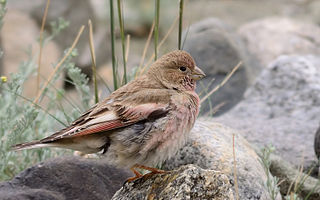
The Mongolian finch, also known as the Mongolian trumpeter finch, is a small passerine bird in the finch family Fringillidae.
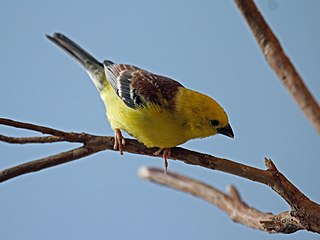
The Sudan golden sparrow is a small species of bird in the sparrow family found in sub-Saharan Africa. It is a famous cage bird, and in aviculture, it is known as the golden song sparrow. The Arabian golden sparrow and this species are sometimes considered one species, as the "golden sparrow".

The blackstart is a chat found in desert regions in North Africa, the Middle East and the Arabian Peninsula. It is resident throughout its range.

The Western Palaearctic or Western Palearctic is part of the Palaearctic realm, one of the eight biogeographic realms dividing the Earth's surface. Because of its size, the Palaearctic is often divided for convenience into two, with Europe, North Africa, northern and central parts of the Arabian Peninsula, and part of temperate Asia, roughly to the Ural Mountains forming the western zone, and the rest of temperate Asia becoming the Eastern Palaearctic. Its exact boundaries differ depending on the authority in question, but the Handbook of the Birds of Europe, the Middle East, and North Africa: The Birds of the Western Palearctic (BWP) definition is widely used, and is followed by the most popular Western Palearctic checklist, that of the Association of European Rarities Committees (AERC). The Western Palearctic realm includes mostly boreal and temperate climate ecoregions.

David William Snow was an English ornithologist born in Windermere, Westmorland.

The grey-headed kingfisher is a species of kingfisher that has a wide distribution from the Cape Verde Islands off the north-west coast of Africa to Mauritania, Senegal and Gambia, east to Ethiopia, Somalia and southern Arabia and south to South Africa.

Menetries's warbler or Ménétries's warbler is a small passerine bird of Southwest Asia belonging to the genus Curruca. The name of the species commemorates Édouard Ménétries, the French zoologist who described the species in 1832. It is closely related to the Sardinian warbler of the Mediterranean basin and is similar to it in appearance.

The crowned sandgrouse is a species of bird in the sandgrouse family, the Pteroclidae from North Africa and the Middle East.

The pale crag martin is a small passerine bird in the swallow family that is resident in Northern Africa and in Southwestern Asia, east to Pakistan. It breeds mainly in the mountains, but also at lower altitudes, especially in rocky areas and around towns. Unlike most swallows, it is often found far from water. It is 12–13 cm long, with mainly brown plumage, paler-toned on the upper breast and underwing coverts, and with white "windows" on the spread tail in flight. The sexes are similar in appearance, but juveniles have pale fringes to the upperparts and flight feathers. It was formerly considered to be the northern subspecies of the rock martin of southern Africa, although it is smaller, paler, and whiter-throated than that species. The pale crag martin hunts along cliff faces for flying insects using a slow flight with much gliding. Its call is a soft twitter.

The streaked scrub warbler, also known simply as the scrub warbler, is a small passerine bird. It is the only species placed in the genus Scotocerca. It is found in northern Africa and south-western Asia. It is a bird of desert fringes, frequenting scrubby areas, ravines and gorges, and is mainly resident, although local movements can occur outside the breeding season.

The red-tailed wheatear, also known as the rusty-tailed wheatear, Persian wheatear or Afghan wheatear, is a small passerine bird breeding in mountainous areas of south-west and central Asia. It belongs to the wheatear genus Oenanthe which was formerly placed in the thrush family Turdidae but is now in the Old World flycatcher family Muscicapidae. The red-tailed wheatear used to be considered a subspecies of the Kurdish wheatear but is now often regarded as a separate species.
Stanley Cramp was a British civil servant and ornithologist best known as the first Chief Editor of the encyclopaedic nine-volume handbook The Birds of the Western Palearctic (BWP).
David Ian "Dave" Nurney is an English bird artist.

















